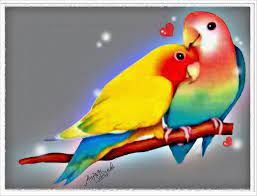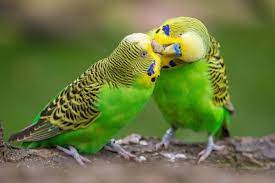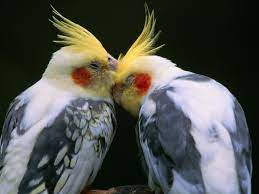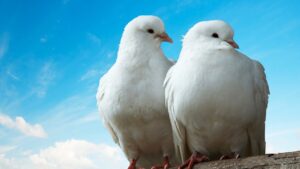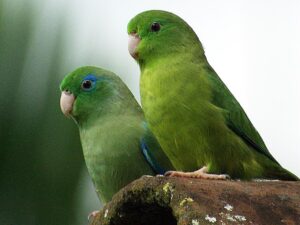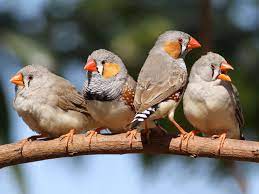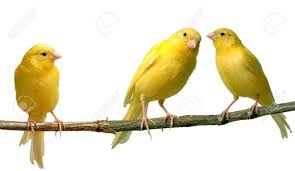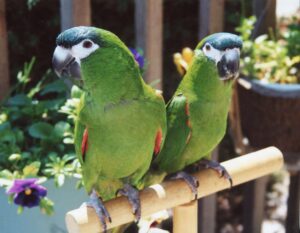Most Popular Exotic Pet Birds That You Can Legally Keep in India
People are increasingly growing fonds of pets in India. This can be attributed to loneliness caused by recent lockdowns, or due to the increasing presence of pets in films and memes!
Pets are awesome to beat the boredom and the companionship they provide. In western countries, and India also, the two most popular pets are dogs and cats.
In India, people have always been inclined towards birds for a very long time. Birds are very popular as pets in India. They are adorable, interactive, smart, friendly-thus very well suited as companions.
These days, cats and dogs are not the only pets Indians want. People are expanding their choices, and birds are finding the much-coveted space in pet owners’ houses. But you can’t catch any bird and keep it as a pet in your home. There are laws like the Wildlife Protection Act that prohibit keeping wild birds as pets. Therefore, before you bring home a wounded wild bird, or buy a beautiful one, ensure that you are not getting yourself into a legal mess. In fact, not following the legalities can land you in jail, or you might have to pay a hefty amount as a fine.
Birds are very intelligent creatures, and they make great pets. They can make you feel better merely by their presence.
A pet bird can bring immense happiness in your life. You will never feel bored because that little, feathered-friend of yours will be there to entertain you. But there are many more advantages to owning a pet bird.
- A pet bird can help you deal with stress. The sweet chirping of the of the birds can help calm your mind and help you relax.
- Birds make great companions. If you live alone or know someone who lives alone, you can gift them a pet bird. They will always have someone to talk to.
- Owning a pet bird, or any other pet can keep you active and alert because taking care of a bird requires some effort. You’ll have to take care of its needs, which in turn will make you responsible and will also help you stay focused.
- Owning a pet bird can also help you build up your social circle. When you own a pet, you’ll find yourself interacting with other bird owners. Soon, it may become a habit, and you will realise that you have a big social circle.
Most Indian bird species are illegal as pets in India. The Wildlife Protection Act says that no one can keep wild birds that are native to India as pets. Anyone taking care of such birds must either hand them over to the forest department or release them in forests, lakes, and parks.
In India, local birds are not supposed to be kept as pets. But, exotic birds such as budgerigars and cockatoos are allowed to be kept as pets. It is common for people to keep parrots as pets but this is illegal, as is keeping mynas and finches that are trapped from the wild and sold in markets.
List of birds that are allowed as pet in India
Here is a list of the best birds as pets. Some people may find that the pet bird they’ve chosen is too noisy or time-consuming for their lifestyle. Then they get frustrated and give the birds away. That’s why it’s so important you get the best pet bird for you.
- Cockatiels
- Budgies [also known as Parakeet]
- Love Birds
- Zebra Finches
- Pineapple Conures
- Dove
- Hyacinth Macaw
- Hahn’s Macaw
- Parrotlet
10.Canary
11.Rainbow lorikeet
12.Golden pheasant
13.Palm Cockatoo
14.Toucan
15.Conure bird
Budgies
These are Australian birds which are also known as parakeets. Budgies belong to the parrot family and are small in size. They are one of the preferred pet choices as they are docile, and can be tamed easily. You will find two kinds of budgies in the market- American Budgies and English budgies. Originally, there were green budgies, but now, you can find different-coloured birds in the shops.
Budgerigars are among the most popular pet birds for good reason. These charismatic little parakeets are loveable and affectionate. They are easy to tame if they are acquired at a young age, and are able to mimic speech like larger parrots. Budgies are easy to care for and are considered excellent “starter birds” by most aviculturists.
Biological Facts
- Budgerigar (Melopsittacus undulatus) – commonly called “budgie”, “shell parakeet”, or just “parakeet”.
- Budgies are only one of a large number parakeet species.
- Two varieties
- American: smaller body, sleeker plumage
- English: larger body, fluffier plumage
- Weight: 30-34 gm
- Young birds have bands on the forehead that fade by 3-4 months
- Adult males have a blue cere (skin surrounding the nostrils); females have pink cere. This rule applies to the natural color varieties, but not to all of the various color mutations
- Sexual maturity: 6 months
- Avg. life span: 6 years
- Maximum recorded life span: 18+years
- Origins: Australia
Behavior
- Very playful and active; can be vocal, but quieter than most parrots
- Budgies can be kept singly if the owner is able to spend a lot of time interacting and bonding with the bird.
- A pair of budgies will keep each other company, but these birds will usually be less tame and not mimic speech as well.
- Hand-fed babies and those that have been handled often will be the easiest to hand tame as they mature.
- Expose early to daily activities in the household. Place cage in area of the home where the family spends the most time.
- Provide environmental enrichment to reduce boredom. Budgerigars are intelligent and curious. They are easily amused with simple toys and love to explore their surroundings
- Budgies should not be allowed unrestricted access in the home where they can encounter numerous dangers. They should be confined to the cage when not directly supervised, and should be housed in a “bird friendly” safe room.
Diet
- Parakeets should not be fed a diet of seed alone. Seeds are nutritionally imbalanced and high in fat, and parakeets that become accustomed to seeds are very hard to switch to a better diet later on.
- Offer your parakeet a wide variety of fresh foods early on: vegetables, leafy greens, fruits, pasta, rice, beans, sprouted seeds. These items should make up about 20-25% of the diet.
- The best option is a pelleted diet specifically formulated for small parrots. Pelleted diets are nutritionally complete and will prevent your bird from picking out only those things he or she likes. Pellets should make up about 75% of the diet.
- Treats, including seeds, should make up only about 5% of the diet
- Clean, fresh water should be provided daily
Environment
- Cage should be as large as possible, with the bird able to fully extend the wings and flap without touching the sides of the enclosure.
- Cage should be clean, secure, safe, and constructed of durable, non-toxic materials, with varied perches, including concrete perches to keep nails worn.
- Spacing of cage bars should be ½ in (1.27 cm) or less; horizontal bars provide the best opportunity for climbing.
- Avoid placing perches directly over food or water to prevent contamination
- Access to natural light is preferred, but avoid drafty areas.
- Birds outside of cages need constant supervision to avoid access to other pets, small children, hot stoves, sinks/tubs full of water, and household toxins.
Preventive Care
- Complete physical examination every 6-12 months
- Consult a veterinarian with experience in avian medicine if you have any questions or concerns about your bird’s health
- Annual fecal examination for parasites, yeast, and bacteria
- Blood work annually, or as recommended
- Wing or nail trimming as needed
Common Medical Disorders
- Tumors
- Obesity
- Chronic egg-laying
- Egg-binding
- Internal and external parasites
- Overgrowth of beak and nails
Love Birds
Originating from the African continent, love birds are also popularly known as pocket parrots. They are very active, charming, loving, curious, playful, and feisty. You can form a great bond with love birds. But you need to tame them properly because they can be aggressive otherwise. Love birds are short and have blunt tails. You can get a pair of love birds in various colours such as green, peach, white, and teal.
Lovebird Care Sheet
Overview
Agapornis spp
Lovebirds are curious, energetic, charming birds originating from Africa. Although they are small, they are part of the parrot family. They are named for the close bonds they form with each other. Due to their desire to bond in this way, they are best kept as pets in pairs. There are nine species of lovebirds, including “eye-ring” species, which have a white ring around their eyes (such as the black-masked and Fischer’s lovebirds), and those without an eye ring, such as peach-faced lovebirds.
Typical lovebird appearance and behavior
- Lovebirds come in combinations of bright colors, including green, blue, orange, red, and yellow
- They have been bred as pets to have many color mutations
- Lovebirds are typically 5–7” long (from head to tail tip) with short, blunted tails (unlike similar-sized budgerigars, which have long, tapered tails)
- They must be handled and interacted with daily to socialize, or they can be stubborn and assertive
- Single lovebirds may bond best with pet parents but generally prefer to be kept in pairs
- They must be provided with safe toys to gnaw on to satisfy their desire to chew
- Lovebirds may be territorial and sometimes cage-protective if not socialized properly
- They have a unique chatter and a naturally loud call; they sing and whistle to each other
- Lovebirds must have a variety of toys, including foraging toys, to provide mental stimulation and combat self-destructive behaviors (such as feather-plucking and skin mutilation) as a result of boredom
Characteristics
| Care difficulty | Beginner |
| Average Life Span | 15+ years with proper care |
| Average adult size | 5–7 inches long, from head to end of tail |
| Diet | Herbivorous |
| Minimum habitat size | 18” W x 18” D x 24” H for a single lovebird |
Habitat
Habitat size
Provide a habitat as large as possible for your lovebird pair. The minimum habitat size for a single lovebird is approximately 24″ W x 18″ D x 24″ H with habitat bars spaced no more than 3/8″ apart so that their heads and limbs do not get caught; a habitat large enough for flight is ideal.
Building your habitat
Lovebirds acclimate well to average household temperatures (not to drop below 65°F or to exceed 80°F); be cautious of extreme temperature changes. The habitat should lock securely and be kept off the floor in a well-lit area away from drafts and safe from overly inquisitive or predatory pets such as cats and dogs. Ensure no habitat parts or toys contain lead, zinc, other potentially toxic heavy metals, lead-based paints or galvanized parts, as these can cause serious medical problems if birds ingest them
- Accessories– Perches should be 1/2″ in diameter and provide enough room for birds to perch comfortably; a variety of perches of different diameters helps prevent pressure sores from developing on the soles of their feet. Sandpaper covers on perches are abrasive to the bottoms of feet and are not recommended; however, one concrete perch amongst various other perches in a habitat can help keep nails in shape
- Bedding– A metal grate over the droppings tray will enable droppings to fall away from the bird’s feet and keep the habitat cleaner; the tray in the habitat bottom should be lined with habitat paper or other paper-based substrate to ease cleanup and minimize dust exposure. To avoid contaminating food dishes with droppings, do not place food or water containers directly under perches
- Food and water dishes– Provide separate dishes for dry food, fresh food and water; if housing a pair of lovebirds, provide more than one feeding station to reduce competition
- Water dishes should be large enough for birds to bathe in; birds who don’t bathe regularly can be misted gently with warm water from a plant mister a few times a week to help maintain a healthy plumage
- Toys–
- Birds are intelligent, so they need to be able to forage for food and other objects, as well as to play with and chew on toys for enrichment and psychological stimulation. Regularly rotate a variety of toys to prevent boredom; without objects to interact with, lovebirds notoriously chew their feathers and mutilate their own skin
- A play gym will allow your lovebirds time outside of their habitat to exercise, keeping them physically stimulated and providing for their social health
- Lighting– Birds need exposure to ultraviolet (UV) light to make vitamin D in their skin, which enables them to absorb dietary calcium. UV light is filtered out by glass in windows, so placing the habitat next to a window is not sufficient; UV lights designed specifically for birds should shine on the habitat 10–12 hours per day and be changed every six months as their potency wanes
Replace perches, dishes, and toys when worn or damaged; rotate new toys into the habitat regularly.
Feeding
What to feed your lovebird
A well-balanced lovebird diet consists of:
- Nutritionally complete and balanced pelleted food specifically formulated for parrots for about 60-70% of diet, plus fresh vegetables, fruits, treats and small amounts of fortified seeds as an occasional treat
- Clean, fresh water, changed daily
Do not feed birds avocados, fruit seeds, chocolate, caffeine or alcohol, as these are toxic and can cause illness and death. Avoid high-salt and high-fat treats.
Things to remember when feeding your lovebird:
- If feeding a pelleted diet specifically formulated for parrots, additional vitamins and supplements are not needed; caution should be taken to avoid over-supplementation
- Fresh food and water should always be available
- Vegetables and fruits not eaten within 10 hours should be discarded
- Treats should not exceed 10% of total food intake
- Although birds are social and like to eat when their flock-mates eat, never share food from your plate or your mouth with them; people have microorganisms in their mouths that can cause serious illness in birds
- Because parrots remove the hulls of seeds before eating them, they do not need to be fed grit or gravel to grind up food
Lovebird care
Bird pet parents should avoid nonstick cookware and appliances, which can release colorless, odorless fumes when heated that typically kill birds once they inhale them.
- Birds need regular grooming, including nail trimming every few weeks to months; nails should be trimmed by a qualified person to prevent injury to the bird
- Beaks should not need regular trimming in most birds, unless they have an underlying condition (such as liver disease) that causes abnormal beak growth. Birds’ beaks normally wear down with daily use; however, the use of a mineral cake or cuttlebone can help keep your lovebird’s beak in good shape
- When done correctly, clipping the outermost five flight feathers can help prevent injury or escape; consult an avian veterinarian on what is best for your bird
Habitat mates
Lovebirds can be kept alone to bond with pet parents or in pairs to bond with each other. Lovebirds are known to pair-bond closely with their mates. Different types of birds should not be housed together.
Health
Signs of a healthy lovebird
- Active, alert and sociable
- Eats, drinks and passes stool throughout the day
- Dry nares and bright, dry eyes
- Supple skin on feet and legs and smooth beak
- Clean, dry vent
- Smooth, well-groomed feathers
Red flags (if you notice any of these signs, contact your veterinarian)
- Fluffed, plucked or soiled feathers
- Sitting on floor of habitat for an extended period
- Wheezing, sneezing or coughing
- Open-mouthed or labored breathing and/or tail-bobbing
- Regurgitation or vomiting
- Runny, bloody or discolored stools or no stool production
- Straining to pass droppings
- Favoring one foot when not sleeping
- Ocular or nasal discharge
- Red or swollen eyes
- Crusty skin around face and feet
- Persistently closed eyes or sleeping during the day
- Loss of appetite
Common lovebird health issues
| Health Issue | Symptoms or Causes | Suggested Action |
| Psittacosis/chlamydiosis | Appetite loss, fluffed feathers, nasal discharge, lime green feces, swollen abdomen, respiratory difficulty and conjunctivitis | Seek immediate avian veterinary attention. |
| Diarrhea | Fecal portion of stool (versus solid white urine portion or clear liquid urine) is not formed; has multiple causes, from diet change to bacterial or viral infection to internal parasites | Consult a veterinarian; ensure proper diet |
| Feather plucking | Bird plucks own feathers; may be due to boredom, stress, poor diet or other underlying illnesses | Consult a veterinarian; relieve boredom with attention, new toys, more stimulation |
| Egg-binding | Swollen abdomen, difficulty breathing, straining to pass stool or bloody droppings | Seek immediate avian veterinary attention |
| Psittacine beak and feather disease | Abnormal feather color, feather loss or beak deformities | Seek immediate avian veterinary attention |
Cockatiels
Cockatiels were first discovered in the northern continent of Australia in 1770, and they are available in different colour patterns. Originally, cockatiels have a grey coloured body along with a yellow face and crest that has an orange patch.
Some common variants of cockatiels include lutino, pearl, albino, opaline, pied, cinnamon, silver, Isabelle, and fawn. The best thing about cockatiels is that they are very easy to tame. In fact, you can teach them to whistle different tunes. They are active, playful, and make for great pets.
Typical cockatiel appearance and behavior
- Cockatiels are known for their generally gentle and affectionate nature, but they can also be feisty and curious when they want to be
- The feather color of the common cockatiel is gray, but many feather color and pattern mutations have been bred, including pearl, white-faced, white-faced pearl, lutino (yellow), pied, albino and other variations; common gray cockatiels also have a patch of orange feathers on each of their cheeks
- With the common gray cockatiel, males and females can be distinguished. Males have deeper gray body feathers and brighter orange cheek feathers than females, who are a more muted orangish gray. Females also have gray barring (horizontal stripes) on the undersides of their tails. Barring is present in both genders until six months of age; after that, only female cockatiels retain it. Males also have solid-colored gray feathers on the undersides of their wings, and females have feathers that are gray with white or yellow spots
- Cockatiels are known for mimicking repetitive sounds and noises; they commonly chirp and whistle. While they are not known for their talking ability, they can learn to whistle back in response to being whistled at. They bond easily with their human companions and become cuddly pets if they are properly socialized
- Parent-raised cockatiels require more time to acclimate to human handling than those who are hand-fed
- Females are prolific egg-layers and may lay an infertile egg (when not housed with males) every other day; proper diet (including adequate dietary calcium and vitamin D) is critical to prevent egg binding, which is when eggs get trapped in the birds’ bodies
Cockatiel characteristics
| Care Difficulty | Beginner |
| Average Life Span | Up to 25 years with proper care |
| Average Adult Size | 11–14 inches, from head to end of tail |
| Diet | Herbivorous |
| Minimum Habitat Size | 24” W x 24” D x 30” H |
Habitat
Habitat size
Provide the largest habitat possible for your cockatiel. The minimum size of habitat for one cockatiel is approximately 24” W x 24” D x 30” H, with metal bars spaced no greater than 1/2” apart so that birds can’t escape or get stuck. Commercially available habitats are generally made with stainless steel bars (either with or without a nontoxic coating). Homemade habitats or those made of wood or galvanized wire are not recommended because birds can chew on them and ingest potentially toxic chemicals.
Setting up your habitat
Cockatiels acclimate well to average household temperatures between 65°F and 80°F; be cautious of extreme temperature changes. Habitats should be placed off the floor in a well-lit area away from drafts and inaccessible to other pets, including curious cats and dogs. Ensure no habitat parts or toys are made with lead, zinc, other potentially toxic heavy metals, lead-based paints or galvanized parts, as these can cause serious medical issues if birds ingest them.
- Perches: Perches should be at least 5” long and 1/2” in diameter; provide a variety of perch sizes so your cockatiel can exercise their feet and help prevent pressure sores from developing on their soles. Sandpaper covers on perches are abrasive to the bottom of feet and are not recommended. Providing perches made from different materials, such as wood, braided rope and natural branches, allows birds to choose which surface they stand on
- To avoid contaminating food dishes with droppings, do not place food or water containers directly under perches
- Toys: Cockatiels are very intelligent, so they need to be able to forage for food and other objects, as well as play with toys for enrichment. Toys for foraging and chewing offer cockatiels important mental stimulation. Size-appropriate toys may be made from cardboard, paper, soft wood or plastic too hard for cockatiels to bite off and swallow. Without proper stimulation, birds get bored and may pick at their feathersor develop other destructive habits, so rotate toys regularly. Ensure toys are strongly attached to the habitat because birds can unscrew the C-clamps that are typically used to hang toys and become injured. Toys also should not have small parts that birds can easily pull off and ingest
- Liner and litter: A metal grate over the habitat bottom will enable droppings to fall away from birds’ feet and keep the habitat cleaner; the tray in the habitat bottom should be lined with habitat paper or other paper-based products to ease cleanup and minimize dust
- Lighting: Birds need exposure to ultraviolet (UV) light to make vitamin D in their skin so they can absorb dietary calcium. UV light is filtered out by glass in windows, so placing the habitat next to a window is not sufficient; UV lights designed specifically for birds should shine on the habitat 10–12 hours a day and be changed every six months when their potency wanes
- Bathing: Water dishes should be large enough for birds to bathe in. Birds who don’t bathe regularly can be misted a few times a week with warm water from a plant mister to help maintain healthy plumage
Cleaning your cockatiel’s habitat
Spot clean the habitat daily, removing discarded food and droppings on perches. Thoroughly wash and dry food bowls daily. Replace substrate or habitat liner weekly or more often as needed, especially if the habitat houses more than one bird.
Regularly clean and disinfect your cockatiel’s habitat and perches by:
- Moving your cockatiel into a secure place (such as another habitat or travel carrier) in a separate air space
- Washing the habitat, perches and toys with a bird habitat cleaner or 3% bleach solution, being sure to thoroughly rinse all trace amounts so there is no residue to which your bird could be exposed
- NOTE: Do not use any cleaning agents not specifically made for pets around your bird because birds’ respiratory tracts are very sensitive to anything aerosolized, and fumes from cleaning products can be harmful
- Thoroughly drying the habitat and its contents
- Replacing the substrate or liner, perches and toys
- Returning your bird to their habitat
Replace perches, dishes and toys when worn or damaged; rotate new toys into the habitat regularly to help avoid boredom.
Feeding
What to feed your cockatiel
To feed your cockatiel a well-balanced diet:
- Nutritionally complete and balanced pelleted food specifically formulated for cockatiels should make up 60–70% of your bird’s diet, plus fresh vegetables, fruits and small amounts of fortified seeds as an occasional treat
- Clean, fresh water should be changed daily
- Egg-laying female cockatiels should always have access to cuttlebones, which are excellent sources of calcium, a nutrient essential for making eggshells and laying eggs
- Do not feed birds avocados, fruit seeds, chocolate, caffeine or alcohol, as these are toxic and can cause illness and death in birds, and avoid sugary, fatty and salty treats
Things to remember when feeding your cockatiel:
- Fresh food and water should always be available
- Vegetables and fruits not eaten within a few hours should be discarded
- Treats should not exceed 10% of total food
- Provide separate food dishes for dry food, fresh food and water; if housing more than one cockatiel in a single habitat, provide multiple feeding stations to reduce competition
- Although cockatiels are social and like to eat when their flock mates eat, never share food from your plate or your mouth; people have microorganisms in their mouths that can cause illness in birds
- Since cockatiels remove the hulls of seeds before eating them, they do not need to be fed grit to grind up food
Cockatiel care
- Bird pet parents should avoid using nonstick cookware and other appliances with nonstick coatings; when heated, these can release colorless, odorless fumes that typically kill birds when inhaled
- Birds should be allowed out of their habitats and gently handled daily to socialize them
- Birds need regular grooming, including nail trimming every few weeks to months; nails should be trimmed by a trained person to prevent injury to the bird
- Beaks should not need regular trimming in most birds, unless the bird has an underlying condition (such as liver disease) that causes abnormal beak growth; birds’ beaks normally maintain in good condition with daily use
- When done correctly, clipping the five outermost flight feathers can help prevent injury or escape; consult an avian veterinarian on what is best for your bird
Habitat mates
Cockatiels can be kept alone to bond with their pet parent or in pairs or larger groups to bond with each other. Different types of birds should not be housed together.
Cockatiel health
Signs of a healthy cockatiel
- Active, alert and sociable
- Eats, drinks and passes stool throughout the day
- Dry nares and bright, dry eyes
- Supple skin on feet and legs and smooth beak
- Clean, dry vent
- Smooth, well-groomed feathers
Red flags (contact your veterinarian if you notice these signs)
- Fluffed, plucked, or soiled feathers
- Sitting on the habitat floor for an extended period of time
- Wheezing, sneezing or coughing
- Open-mouthed or labored breathing and/or tail bobbing
- Regurgitation or vomiting
- Runny, bloody or discolored stools or no stool production
- Straining to pass droppings
- Favoring one foot when not sleeping
- Ocular or nasal discharge
- Red or swollen eyes
- Persistently closed eyes or sleeping during the day
- Crusty skin around face and feet
- Loss of appetite
Common cockatiel health issues
| Health Issue | Symptoms or Causes | Suggested Action |
| Chlamydiosis (psittacosis or parrot fever) | Appetite loss, fluffed feathers, nasal discharge, lethargy, swollen abdomen, sneezing, labored breathing, lime green feces, conjunctivitis | Seek immediate avian veterinary attention |
| Conjunctivitis | Red eyes, tearing, closed, puffy eyes; may be due to bacterial, viral or other infectious organisms | Consult your veterinarian and wipe your bird’s eyes with warm water |
| Diarrhea | Fecal portion of stool not formed; has multiple causes, from change in diet to internal parasites | Consult your veterinarian and ensure proper diet |
| Egg binding | Swollen abdomen, straining to pass droppings, bloody droppings, lethargy, decreased appetite, labored breathing, laying soft-shelled or shell-less eggs | Seek immediate veterinary attention |
| Night frights | Episodes of violent, uncontrolled wing flapping and screeching at night | Turn on the light and speak softly to bird to help calm them; call your veterinarian if your bird’s episode does not stop or if episodes are frequent |
Dove
They can be seen flying freely in some places of India, and their distinct sand colour and big black eyes attract bird lovers. There are almost 300 species of doves, but the ring-neck is the favourite among pet owners. Their origin is traced back to Africa, but slowly they made it to every continent. They are very domesticated birds and easy to tame. They are sweet, gentle, and best as family pets.
Parrotlet
Bring home parrotlet if you are looking for a small and cheerful companion in your boring city life. These colourful, cheerful, and affectionate birds make your life a great deal better. They are chirpy, adorable, beautiful, and easy to tame. They are the smallest birds of the parrot family. Their miniature size, their curved beaks, a whispering chirp, vibrant colours, and affection will win you over. Take care of them else they become aggressive.
Zebra Finches
When you look at these colourful creatures, you won’t find any reason not to buy them. A beautiful red beak, black and white tail, grey feathers, and yellow colour make them a very beautiful sight to behold. Their voices are quiet and very musical. Their native home is in Australia, Portugal, Costa Rica, and other places, but they are found everywhere. They love water and living with a partner. They have no special need, but a strong bond in life is what they seek. Do you think you can give it to them? Then bring them home.
Caring for Zebra Finches
Sounds
Finches are fairly quiet birds. You won’t have to worry about your pets picking up inappropriate words, or yelling at you. Finches aren’t entirely silent, however. Many of these cute birds respond when they are spoken to or whistled at, and they often greet their owners with adorable beeps and chirps, especially at dinnertime. Cuteness alert: if your zebra finches are near a window, they may respond to the calls of wild birds.
Company
These little cuties are very sociable, and should be kept in groups or pairs. Although they are very gentle, they are not necessarily affectionate towards their owners. While you may occasionally find a finch that likes being handled, or will perch on your shoulder, most of the time they prefer the company of their own kind.
Feeding
Finch seed should form the basis of your feathered buddies’ diet. You can supplement this with hard-boiled eggs, spray millet, grubs, and leafy greens. You’ll also want to make sure your finches always have cuttlebone. Ask your vet for specific information.
Cage
Making sure your feathered friends are comfortable in their cage is very important. For a single pair of finches, you’ll need a cage that is at least 30” x 18” x 18”. If you have more birds, you’ll need a larger cage. Bigger is better, however, so get the largest cage you can afford. Finches need more vertical space than horizontal, so get one that is more wide than it is tall, with bars that are spaced no more than a half-inch apart. If you like, you can keep organic grass in your finches’ cage. Your little buddies will also appreciate having some non-toxic plants placed near their habitat. Ask your vet for more information.
Toys
Like all birds, finches need stimulation. Provide plenty of fun toys for your winged friends to play with. Canary tassel toys are often a big hit with these tiny birds. You’ll also need to provide perches.
Canary
They got their name from their birthplace, which was in the Canary Islands and Madeira. They belong to the finch family. They are small, beautiful, and friendly birds that can be trained easily. The ancestors of these birds were captive until the 17th century. Maybe it was their beauty that melted their captors’ hearts, and today, these are available everywhere in different colours and sizes. These are social birds, so either keep them in pairs, or you can keep them with other birds in your aviary as well. But they also don’t mind living alone. They will become a perfect companion for you.
Hahn’s Macaw
If you are looking for another smaller-sized pet, Hahn’s macaw can be a beautiful and chirpy choice. There are two types of red-shouldered macaws, and Hahn’s Macaw is one of them. They are small, charming, affectionate, and make good pets. Their native place is in South America, but you can find them in Indian shops and get one for your home. Get a macaw if you need an alarm clock that will go off at sunrise without any delay.
Pineapple Conures
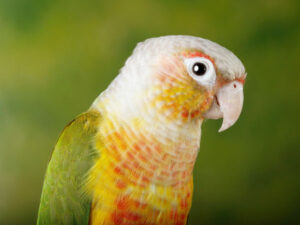
They look nothing like pineapple but a beautiful green, red, and yellow mango with big eyes and an amazing personality. These small-sized birds are natives of South America, Argentina and Paraguay. They are quiet birds who love to play, hop and engage in different activities. If you want a colourful friend, then bring home a Pineapple Conure.
Hyacinth Macaw
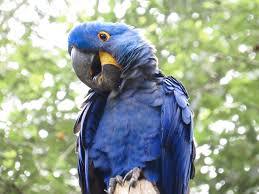
The list wouldn’t be complete without including Hyacinth Macaw. This cobalt bluebird comes under the category of the large bird as it is almost one meter in size. It can be seen commonly in zoos, but you can bring it home. Its colour is what attracts everyone. This South American native becomes a good friend and family member. But bring it home only if you can take good care of this bird as it is an endangered species.
Basic Care for your Pet Bird
Biological Facts
- Budgies may live 10-12 years or more
- Cockatiels may live 15-20 years or more
- Larger parrots may live 25-50 years or more
- Cockatiels weight averages 75-125 gm; Budgies average 30 gm; cockatoos average 300-1000 gm; other large parrots average 300-600 gm with macaws getting up to 1500 gm
Behavior
- Parent-raised (until weaned) birds are better adjusted those raised entirely by humans
- Human handling during this time results in more tame adult birds
- Tamed birds readily adapt to new surroundings and activities – expose early to daily activities in your household as well as to other pets
- Birds are intelligent, curious, and are easily amused with simple toys and love to explore their surroundings
- Birds need environmental enrichment to reduce the chance of feather picking
- Birds with unrestricted access in the home will encounter numerous dangers and should be housed in a “bird friendly” safe room.
Diet
- Birds need fresh, specifically formulated diets, such as Harrison’s or Zupreem diets
- Treats should be limited to only 5% of the diet; dark green vegetables and fruits can be 10-30% of diet
- Clean, fresh water should be provided daily
Housing
- Enclosures should be as large as possible, with the bird able to fully extend it’s wings and flap without touching the sides of the enclosure
- Enclosure should be clean, secure, safe and constructed of durable, non-toxic materials, with varied perches such as Polly’s Pet Perches
- Avoid placing perches directly over food or water to prevent contamination
- Access to natural light is preferred, but avoid drafty areas.
- Birds outside of cages need constant supervision to avoid access to other pets, small children, and any household toxins.
Preventive Care
- Bi-annual physical examinations
- Fecal examinations
- Blood work annually for adults
- Wing trimming every 3-6 mths, as needed
Common Disorders of Chicks:
- Crop disorders/ burns
- Trauma
- Foreign body aspiration
- Fungal, bacterial, and viral infections
- Candida yeast infection
- Hypothermia
Common Disorders of Adults:
- Behavior – feather picking, screaming, aggression and biting
- Respiratory diseases
- Fungal, viral , and bacterial infections
- Obesity
- Parasites
- Reproductive disorders, such as egg binding and cloacal prolapse
FAQs
Is it legal to keep birds as pets in India?
In India, as per the Wildlife Protection Act (1972), exotic birds that are not native to India can be kept as pets while the local birds are categorized under wild animals and are illegal to keep as pets.
In short, We cannot keep local birds as pets but foreign exotic birds like Cockatoos and Budgerigars can be kept as pets.
Are parrots legal in India?
No, parrots are native birds of India and cannot be kept as pets.
Is Love Birds legal in India?
Lovebirds are originated in South Africa & Madagascar and are not native to India. They are not covered under the Indian Wildlife Act but are banned for trade in India.
Can we keep Peacock at home in India?
No, since Peacock is included in the Schedule I species in the Wildlife (Protection) Act and is also the National bird of India, keeping peacock at home as a pet is illegal in India.
How to make a bird-like you & form a bond with you?
Usually, pet birds are easy to connect with their owners, some may take longer to like you. To form a bond with your pet bird, approach them slowly, use soft speech, comfort and offer their favorite treat.
What are the best pet birds for beginners in India?
You can consider finches or canaries if you have no experience with birds before.
What is the punishment for keeping illegal birds in India?
If the bird is categorized under Schedule 1 then the accused can be punished with 7 years of imprisonment or a penalty of up to Rs. 25,000 or both.
Which animal pet is legal in India?
There is a list of animals that can be kept as pets and they are: Mammals: Camels, cats, dogs, donkeys, cattle, horses, pigs, sheep, goats, and so on. Birds: Parrots, chickens, ducks, geese, columbines, and many more. Fish: Goldfish, koi, guppy, Oscar, Mosquitofish, etc.
Can you keep exotic pets in India?
A voluntary disclosure scheme announced by a central government advisory in June 2020 urged Indians to declare possession of any exotic live species, i.e. any animal or plant species moved away from their native region. No action would be taken even if owners lacked proper documentation.
What are illegal pets in India?
We have listed a few of the pets banned in India.
- Birds. Keeping birds in captivity is cruel – but a lot of us believe a bird is a hassle-free pet to have.
- Tortoise and turtles. Some species of tortoise and turtles are not legal to own in India.
- Sea world.
- Snakes.
- Monkeys.
Can I pet a crocodile in India?
Says Jose Louies of the Wildlife Trust of India, “According to The Indian Wildlife Protection Act, 1972, it is illegal to keep as pets any animal or bird that is found in the wild.” He adds, “So while Indian species are protected in the country, they are not protected anywhere else.
Is Monkey legal in India?
Answer: Monkeys are revered in Hinduism and devout Hindus often feed them. Monkeys, like other wild animals, can’t be kept and trained for entertainment purposes in India under Section 22 (ii), PCA Act 1960.
Can I pet a tiger in India?
You can own leopards, tigers and lions in Mumbai | Mumbai news – Hindustan Times….Why just cats and dogs? You can own leopards, tigers and lions in Mumbai.
Can I pet chimpanzee in India?
Chimpanzees should never be kept as pets — they are undomesticated wild animals and they do not make good pets. To become a pet, they must be taken from their mothers at a very early age, which often means the mother is killed in order to access the baby chimp.
Is parrot pet illegal in India?
no, parrots aren’t legal in India unless they’re an exotic or foreign parrot from another country. Any parrot that’s actually from the country is illegal for someone to cage and keep as a pet.
Can I pet owl in India?
Kartick Satyanarayan, chairman and co-founder of Wildlife SOS, says that the owl is a protected bird under the Wildlife (Protection) Act of 1972. An illegal trade in owls and other birds still exists for their use as pets, to be forced to perform, for sacrifice or other reasons.”
compiled & Eddited by MANOJ POKHRIYAL,ORNITHOLOGIST,UK



